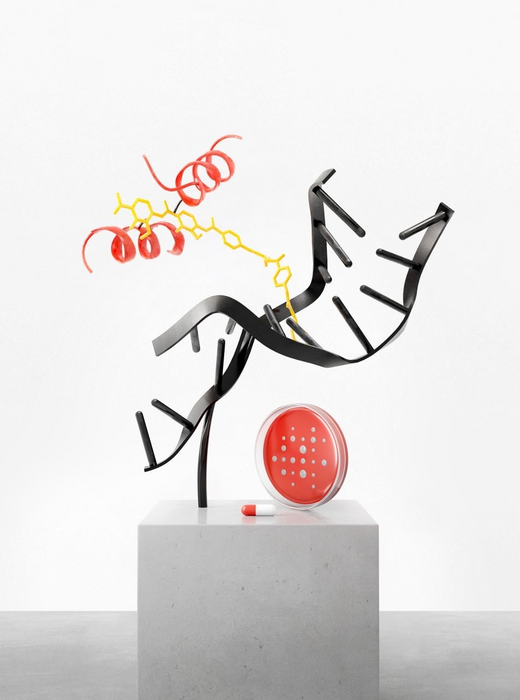A potent plant toxin known as albicidin, which has a unique way of killing harmful bacteria, has emerged as one of the strongest new antibiotic candidates in decades. However, its pharmaceutical development has been hampered because scientists haven’t known how the molecule interacts with its target, the bacterial enzyme DNA gyrase. An international research team headed by Dmitry Ghilarov, PhD, at the John Innes Centre, and colleagues in Germany and Poland, has now exploited advances in cryo-electron microscopy (cryo-EM) to obtain a first snapshot of albicidin bound to the gyrase enzyme target.
The Ghilarov group, working with scientists in the laboratories of Roderich Süssmuth PhD, at Technische Universität Berlin, and Jonathan Heddle, PhD, at Jagiellonian University, suggest that the way albicidin interacts with gyrase is sufficiently different from that of existing antibiotics that albicidin and its derivatives are likely to be effective against many of the current antibiotic resistant bacteria. “We believe this is one of the most exciting new antibiotic candidates in many years,” Ghilarov stated.” It has extremely high effectiveness in small concentrations and is highly potent against pathogenic bacteria—even those resistant to the widely used antibiotics such as fluoroquinolones.” Ghilarov acknowledged to GEN that with a view to the further development of albicidin antibiotics, demonstrating safety and clinical effectiveness will take years, and the timeline for the clinic will depend on interest and development funding, “so it’s very hard to predict. I can say that now when we have the structure with the target, we can make precise modifications to keep the potency but improve solubility and other desired properties to speed up development. It is like we previously were trying to search the room in the darkness and now we can see what we need to do.”
Ghilarov and colleagues reported on their findings in Nature Catalysis, in a paper titled “Molecular mechanism of topoisomerase poisoning by the peptide antibiotic albicidin,” in which they stated, “In summary, our work provides the structural framework explaining multiple previous observations based solely on chemical synthesis and activity profiling.”
The antibiotic albicidin is produced by the bacterial plant pathogen Xanthomonas albilineans, which causes the devastating leaf scald disease in sugar cane. Albicidin is thought to be used by the pathogen to attack the plant, enabling its spread. It has been known for some time that albicidin is highly effective at killing bacteria including Escherichia coli and Staphylococcus aureus. “The peptide antibiotic albicidin is a DNA topoisomerase inhibitor with low-nanomolar bactericidal activity towards fluoroquinolone-resistant Gram-negative pathogens,” the authors wrote. Such superbugs, notorious for their increasing resistance to existing antibiotics, have prompted a vital need for effective new drugs.“Ghilarov further explained to GEN, that while the original albicidin molecule demonstrated limited activity against gram-positive micro-organisms, “subsequent chemical modifications have made the antibiotic equally effective against Gram-positive, and Gram-negative pathogens.”
The albicidin target, type II topoisomerase DNA gyrase, is an essential enzyme in bacteria. The enzyme binds to DNA and, through a series of elegant movements, twists it up, a process known as supercoiling, which is vital for cells to function properly. However, gyrase has an Achilles heel; to do its job it must momentarily cut the DNA double helix. This is dangerous, as broken DNA is lethal to the cell. Normally, gyrase quickly joints the two pieces of DNA back together again as it works, but albicidin prevents this from happening, resulting in broken DNA and bacterial death.
The gyrase enzyme is absent in humans, and so represents “a major antibiotic focus,” the team continued, “being the target of the widely used fluoroquinolones (FQs), the last class of broad-spectrum antibiotics to have been introduced into general clinical practice.” And as the team further noted, “Natural product inhibitors of DNA gyrase represent a largely untapped reservoir of molecules that have the potential to be developed into novel classes of highly effective antibiotics. To achieve this, a structural understanding of their mechanisms of action is very useful.”
The team’s newly reported cryo-EM study has shown that albicidin forms an L-shape, enabling it to interact with both the gyrase and the DNA in a unique way. In this state gyrase can no longer move to bring the DNA ends together. The effect of albicidin is akin to a spanner thrown between two gears. “This molecule has been around for decades”, continued Ghilarov, “Now advances in cryo-electron microscopy has made it possible to determine structures of even the most elaborate protein-DNA complexes. To be the first person to see the molecule bound to its target and how it works is a huge privilege, and the best reward one can have as a scientist. But this work is a big team effort, and we would not have done it without our European colleagues.”
The way albicidin interacts with gyrase is sufficiently different from existing antibiotics that the molecule and its derivatives are likely to be effective against many of the current antibiotic resistant bacteria. “It seems by the nature of the interaction, albicidin targets a really essential part of the enzyme and it’s hard for bacteria to evolve resistance to that,” said Ghilarov. “Now that we have a structural understanding, we can look to further exploit this binding pocket and make more modifications to albicidin to improve its efficacy and pharmacological properties.”
This work is already under way. The team used their observations to chemically synthesise variations of the antibiotic with improved properties. In tests, these variants were effective against some of the most dangerous hospital-acquired bacterial infections including E. coli, Klebsiella pneumoniae, Pseudomonas aeruginosa and Salmonella typhimurium.
The next step for this research is to engage with academic and industrial collaborators, and to seek funding to take the research forward to human clinical trials. This could lead to the development of an urgently needed new class of antibiotics in the face of a global threat of antimicrobial resistance, AMR. “Our work now enables a rational structure-based design which preserves albicidin’s distinct and potent inhibition mechanism,’ the authors stated.”


